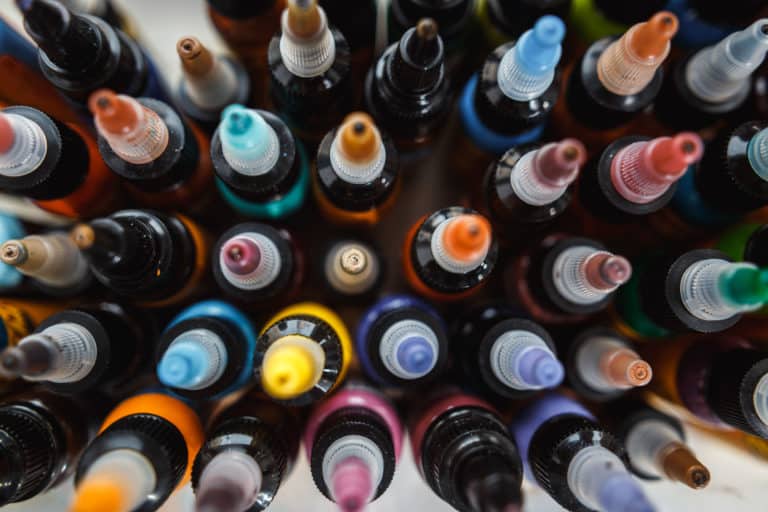When you get a tattoo for the first time, it’s pretty normal to experience different emotions and things you may have never thought about before. What cause us to feel more nervous before and after the tattoo process is the tattoo pain we may experience and its after-effects. One of the most common concerns after getting a tattoo, especially for first-timers, is ink bleeding.
Sometimes your tattoo tends to bleed out ink, which may scare you if your tattoo is coming off. But there are many reasons why that may happen, and not all are scary. In fact, ink bleeding is a sign of a fair tattoo healing process. To learn more about the reasons behind tattoo ink bleeding and to avoid the state of panic, you must read this article below. You will also understand how to prevent such an instance in the first place.
Is it Normal for a Tattoo to Bleed ink?
If you notice ink bleeding out from your tattoo, make sure not to panic, as this is something very common. During the tattooing process, the ink settles deep into your skin due to the tattoo machine. Sometimes instead of penetrating the skin layer, the ink stays on the skin’s surface, while some may gather in small scabs above the tattoo design. You should take ink bleeding as a good sign because this is one of the first things that let us know that the tattoo is going through a safe and successful healing process.
During the healing process, your skin starts recovering from the trauma caused by the tattooing machine. Hence, the ink begins to leak as a means of getting away from your skin. This doesn’t mean that all of the ink will leave your tattoo, and all you will have is a simple tattoo outline. If you take proper care as soon as you’ve got your tattoo, there will still be some ink left that will help brighten up your whole tattoo look.
Are there Steps you can take to Prevent Ink Bleeding?
Bleeding is part of your tattoo’s healing process, and no matter how much you want to avoid it, it will tend to happen. It depends on how much ink your skin tries to flush out or the ink remaining 
The best way to avoid excessive tattoo ink bleeding is by getting your tattoo done by an experienced tattoo artist who haS good reviews. You must also avoid alcohol consumption a few days before and after your tattoo appointment. Alcohol causes your blood to become thin, which leads to clotting. This means that ink leaking will last for long and might ruin the outlook of your tattoo.
Another useful step to avoid ink leaking is keeping your tattoo clean. You can clean your tattoo using warm water and an antibacterial soap. While cleaning, make sure not to rub too harshly as this could lead to more ink bleeding.
Why Does a Tattoo’s Ink Bleed?
As mentioned earlier, tattoo ink bleeding is a common thing that happens during your tattoo’s healing process. Discussed below are the two main reasons why this may occur:
1. Your Immune System Works towards Getting Rid of the Ink
As soon as the ink starts to settle in your skin, your immune system works towards getting rid of the ink. In many cases, your white blood cells can’t absorb too many large ink molecules. Hence, as the ink molecules start to break down into smaller particles that get absorbed into your bloodstream, it results in waste, which is when ink bleeding takes place.
2. Extra Ink Packing
During your tattoo process, your tattoo artist will sometimes try to inject as much ink as possible into your dermis. When the ink in your dermis (skin layer) reaches beyond capacity, you naturally start to witness ink bleeding. Sometimes the ink bleeding comes with plasma, body fluids, and sweat, resulting in extra oozing of ink. You can never know if you’re injecting the right amount of ink as the tattoo artist doesn’t know how thick your dermis is. So it’s better to inject more ink than less, as less ink could result in a poor quality tattoo.
Do Old Tattoos Bleed Ink?
Usually, tattoos bleed ink during the healing stages. However, there is a possibility that you may not precisely experience ink bleeding but may develop an infection. Tattoo blowouts and infections very commonly develop after the healing stages of your tattoo. One of the main reasons for this is that you’re not taking proper care of your tattoo or exposing it to the sun too much. The primary inked bleeding takes place only during the first two weeks of the healing process.
What do I do if My Tattoo Bleeds?
The first thing you must do when you notice your tattoo bleeding ink is clean your tattoo. You can clean the leaked out ink with an alcohol swab or warm water and soap. Use any of these methods and gently rub around the leaking area. Don’t rub too harshly, as this may lead to an even bigger problem, ruining your tattoo. Once you’re done with cleaning, apply a thin layer of lotion, and moisturize your tattoo area. This keeps your skin hydrated and may prevent any further dryness that could lead to ink bleeding and scabbing.
You will have to sleep in a particular posture as the bleeding ink could stain your clean bedsheets and may make the bleeding worse. It’s better not to sleep on a new bed sheet as you don’t want it to get dirty because of ink stains on your bed sheet. Next, sleep in a position that the tattooed area doesn’t make contact with your bed. Otherwise, when you wake up in the morning, you could find ink stains on the sheet or the tattooed skin stuck to your bed sheet. If you come across such a situation, don’t just harshly pull the bed sheet from your skin, as this may lead to patchiness in your tattoo design.
Is it Normal for a Tattoo not to Bleed?
It is completely normal for your tattoo to bleed; this is especially common among people who have thick skin. However, the aftercare for your tattoo may change a bit if your tattoo doesn’t bleed. All you have to do is regularly clean your tattoo using soap and cool water and then apply a small amount of Aquaphor. Make sure to moisturize your skin as well using a good lotion. Washing may trigger your tattoo ink to start bleeding, but you can take care of that by continuing your tattoo cleaning regime.
Can Tattoo Ink Bleed under/into the Skin?
Yes, internal ink bleeding is very common and is referred to as a tattoo blowout. This tends to happen when the tattoo artist usually injects too much ink in your skin in the wrong way. It also happens when the ink does not get injected into the right area. You may rightfully blame your tattoo artist for something like this to happen; however, it’s not always the artist’s fault as it depends 
When performing a tattoo on a thick skin and if the artist pushes the tattoo needle too harshly into your skin, your deep skin tissue layers will directly get infected and result in a faded or fuzzy looking tattoo. Blowouts are more common among thin skin as the lower layers of the skin tend to bleed more often. This is usually common in placement such as the hands, elbows, knees, toes, and fingers.
Suppose your tattoo artist is in a bad mood and tends to become too aggressive with the tattooing needle. In that case, there are higher chances of ink spreading into the surrounding areas of your skin, causing excessive internal ink bleeding. This is one of the reasons why you must always go to an experienced and well-trained tattoo artist. The most that will happen to your tattoo with internal ink bleeding is a faded and blurry looking tattoo, which may be hard to get rid of or improve. You can do a few things, but it does involve a lot of time and money.
How long will a Tattoo Bleed Ink?
There is no specific time-frame for the ink bleeding to stop as it solely depends on the working of your immune system. The maximum time it lasts is for around 2 or 3 days, but it could go up to more than three days and depend on certain things. If the ink continues to leak for almost a week, this is a sign that you may have developed an allergic reaction to the ink. In this case, you must immediately consult your tattoo artist and skin doctor.
How to keep Tattoo Ink from Bleeding onto Clothes?
The ink may get into your clothes when bleeding; however, you can do a few things to prevent the ink from ruining your clothes. The first thing you must do is wear clothes that don’t directly contact the area you’ve got your tattoo on. For example, if you have a tattoo on your legs or thighs, it’s best to wear loose shorts or a skirt and avoid wearing tight or skinny jeans. If you’ve gotten a tattoo on your hand or back, it’s best if you wear something sleeveless or backless.
If you have full clothing on during the ink leaking process, it’s best not to wear new clothes. You can choose to wear loose clothing that won’t stick to your body or any old dress that you soon plan to get rid of in a few days. To lessen the bleeding, keep cleaning the area regularly with hot water and soap; simply use anti-bacterial wipes. It’s best if you don’t expose the areas to outside pollution, so try your best to stay indoors if you can.
How do I Stop My Tattoo from Bleeding Ink (should I do this)?
If the ink bleeding gets too much, which sometimes gets annoying, you can do a few things to lessen the bleeding or completely stop it.
Wipe Your Tattoo
Using a wipe or cloth, you can gently clean the leaked ink off around the tattoo. Make sure not to run on the tattoo, as this would only ruin your tattoo design. You will at first notice bleeding once the tattoo artist has wrapped your tattoo with a plastic wrap. You can wipe once you’ve removed the wrap or do it if it’s getting outside the wrap.
Wash Using Hot Water and Soap
Cleaning with water and soap is one of the main aftercare steps and is the best way to stop the ink from bleeding. Use an anti-bacterial soap and gently rub it around your tattoo, and wash it with lukewarm water. This step will help get all the remaining clogged up ink. You can also use anti-bacterial wipes for a finishing touch and leave you with a neat tattoo look. The bleeding may start 
Mentioned above are the two best ways to instantly stop your tattoo form bleeding and are the first two steps you should follow. There are other few things you can do before your tattoo appointment to avoid ink bleeding from your tattoo. It is best if you avoid alcohol consumption before your tattoo appointment as this causes thinness in the blood, making it more painful and most challenging for your skin to absorb ink. The more ink your skin rejects, the more ink bleeding you will experience.
You must also carry out adequate research on the different tattoo artists around you and choose the best one with good reviews. Going to an unprofessional tattoo artist may lead to higher chances of ink bleeding. One of the few reasons for excessive ink bleeding is when the tattoo artist too harshly injects the ink into your skin in the wrong area using a wrong movement. However, sometimes, the skin dermis cannot take in too much ink, which isn’t the tattoo artist’s fault. But, professional and experienced tattoo artists can deal with such situations professionally and in the right way.
Can a New Tattoo be ruined by Bleeding too much Ink?
Ink bleeding is quite common when you get a tattoo for the first time, but this doesn’t mean that your tattoo gets ruined. What will allow the bleeding to ruin your tattoo is not carrying out and following proper aftercare instructions and keep cleaning the ink that’s spread on your tattoo’s outer areas.
This is why following steps like cleaning with warm water and a cloth is essential as you don’t want the leaked ink dried up on your skin. If you leave the ink as it is, it will only cause fading and scabbing. The other thing you can keep doing is using anti-bacterial wipes and keep your tattoo moisturized with a good lotion. Avoid scented lotions as this would only cause further dryness and may damage your skin, thus increasing the risk of infection. Not to mention, it could be far worse than the ink bleeding from your tattoo.
People often worry when they see ink bleeding out from their tattoo, especially when they don’t expect it. But, it’s best to relax and, instead of panicking, follow the aftercare steps that will lessen the bleeding and leave you with a beautiful, perfectly healed up tattoo.
What should you expect after Getting a Tattoo?
A few things will happen during or after your tattooing process that may first freak you out. But you can avoid them and address those issues the right way.
Scabbing
Scabbing is a common yet itchy process that takes place during the healing process of your tattoo. If you see signs of scabbing, it means your tattoo is going through a smooth healing process. You will have the urge to scratch your tattoo due to feelings of excessive itchiness, but do your best to resist this urge. Scratching would only lead to a messed up design, which is the last thing you want while your tattoo is still fresh.
Bleeding During and After the Tattooing Process
Ink bleeding is one of the most common things you will experience during and after the tattooing process. As soon as the ink gets injected into your skin, your immune system starts functioning to eliminate the ink. This also happens when too much ink gets injected into the debris, resulting in excessive ink bleeding.
Redness
Redness and swelling are likely to occur after the tattooing process as your skin goes through quite a lot of trauma from the tattooing machine. This takes a few days to get back to normal.
Pimples
You may notice the growth of a few pimples around your tattoo, and the main reason for this could be excessive use of a moisturizer. Hence, make sure you are using the right one in the right amount.
Final Word
Getting a tattoo, especially for the first time, can be quite a daunting experience as you’re not sure what to expect and how to deal with certain situations such as tattoo ink bleeding. With the help of this article, you hopefully have all your questions regarding ink bleeding answered. Now all you need to do is use this information whenever you plan to get your first or next tattoo.

